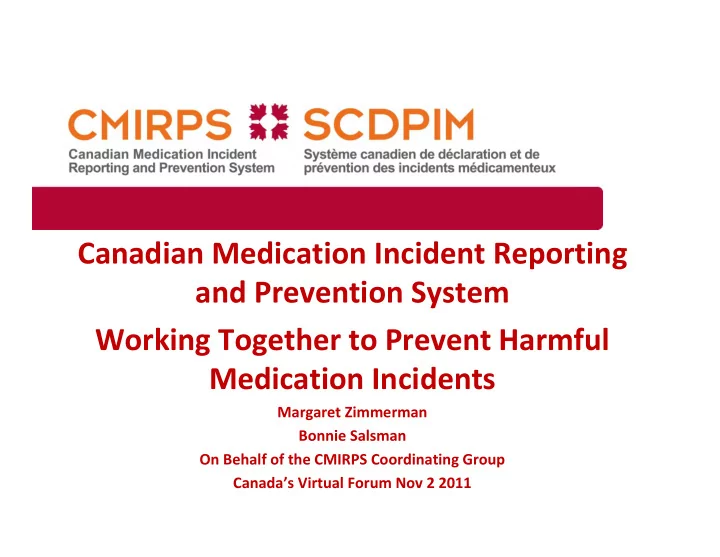

Canadian Medication Incident Reporting and Prevention System Working Together to Prevent Harmful Medication Incidents Margaret Zimmerman Bonnie Salsman On Behalf of the CMIRPS Coordinating Group Canada’s Virtual Forum Nov 2 2011
National Post – April 29, 2001 2 0 0 2 , 2 1 e n u J – i l a M d n a e b o G l Group warns of feeding tube and IV line mix-ups CTV News – September 4, 2007
Objectives • Introduce the Canadian Medication Incident Reporting and Prevention System (CMIRPS) • Illustrate how the CMIRPS partners work together to enhance the safety of Canada’s medication use system • Discuss the importance of sharing information for the prevention of harmful medication incidents in Canada
CMIRPS Collaborating Organizations • Health Canada • Canadian Institute for Health Information (CIHI) • Institute for Safe Medication Practices Canada (ISMP Canada) • Canadian Patient Safety Institute(CPSI)
www.cmirps-scdpim.ca
This presentation will use fictional drug names and a fictional scenario to illustrate how CMIRPS works. Any resemblance to real drugs or persons is purely coincidental
Soltefam • Anxiolytic • Used for agitation in elderly Faltasan • For ADHD • Contraindicated in hypertension, CAD • New indication-smoking cessation
Types of Incident Reports
Hazardous Situation Report • Health professionals or consumers recognize potential for mix-ups with sound-alike names • Also known as “Reportable Circumstance” in NSIR
Near Miss Incident Report • Order for Faltasan is interpreted as Soltefam but error identified before medication is dispensed or administered
No-harm incident Report • Faltasan dispensed for Soltefam in community pharmacy; error identified by consumer after only one dose taken
Harmful incident Report • An elderly man is admitted to hospital. A family member states that the patient is taking Soltefam, but the admitting physician mistakenly interprets this as Faltasan. The patient receives Faltasan for three days and suffers a stroke.
CMIRPS Reporting Tools • Canadian Institute for Health Information – National System for Incident Reporting (NSIR) • ISMP Canada – Individual Practitioner Reporting system (IPR) – SafeMedicationUse.ca
Key Features of NSIR • Web-based application for healthcare organizations • Facilities can access own data and de- identified data from other facilities • Integrated Tools • Complements risk management systems 14
ISMP Canada • Individual Practitioner Reporting – collects reports directly from practitioners in settings where NSIR is not available – On-line or telephone • SafeMedicationUse.ca – Consumer-friendly reporting mechanism – On-line or telephone 17
Privacy and Confidentiality • Appropriate Measures for Protection of: – Privacy – Data security • Data Sharing Agreements allow sharing of information
Analysis • The purpose of analysis is to identify hazards, issues, contributing factors and underlying causes of medication incidents. • Priority for analysis is given to reports where the incident led to or could potentially lead to serious outcomes. • The analysis of individual reports is done by ISMP Canada and Health Canada.
Analysis • The types of analyses conducted can include individual report review and aggregate review. • The focus is on identifying underlying issues. • Health Canada becomes involved in analysis of reports involving product- related issues.
Analysis • Searching of databases is an essential step in the analysis process. • Incidents that occur in one jurisdiction have a high likelihood of recurrence elsewhere. • A proactive approach is used to identify trends and emerging issues.
Sample NSIR Report 23
Solutions Development • Prevention strategies , as well as strategies to mitigate harm are developed. • These strategies are dependent upon on the nature of the issue. • Through CMIRPS, work is done at the local, regional, provincial/territorial, national and international level.
Sharing CMIRPS Learning • ISMP Canada Safety Bulletins • ISMP Canada SafeMedicationUse.ca Newsletters and Alerts • Health Canada “Dear Healthcare Provider” letters • CPSI Global Patient Safety Alerts • ISMP Canada workshops, webinars, toolkits
Health Canada Health Professional Communication
Health Canada Public Communication
Other Actions • Consideration of a name change or label change • Review of policies and procedures to prevent or mitigate risks • Changes to Accreditation Canada standards or professional standards • CPSI supports other related patient safety initiatives
��������������������������� ���������������������������
Example of Changes to Standards http://www.ornac.ca/standards /
Summary • CMIRPS is a collaborative program that contributes information, tools and expertise to enhance the safety of the medication use system • Reporting by healthcare professionals, consumers and patients contributes information that enables the identification of problems, analysis of information and sharing of solutions by CMIRPS • Working together, we can prevent and reduce harmful medication incidents
www.cmirps-scdpim.ca
Recommend
More recommend